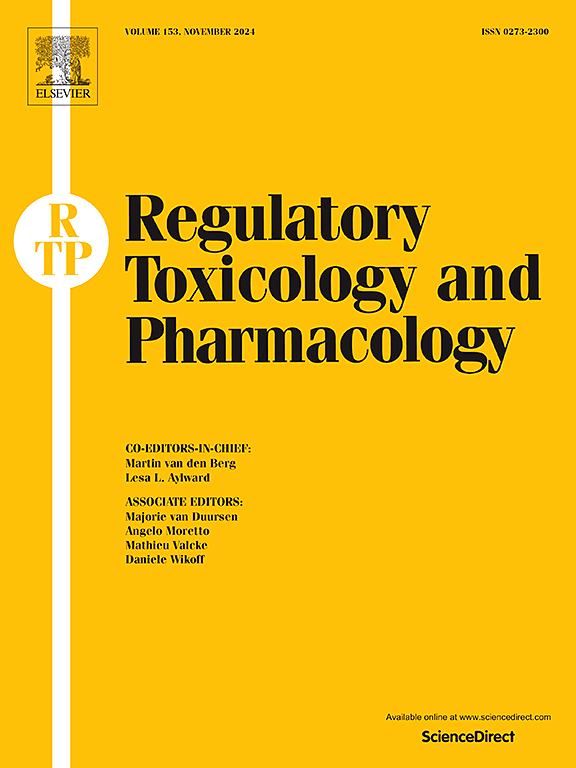结合crbn的靶向蛋白降解剂的非临床致畸安全性评估:需要考虑的问题
IF 3
4区 医学
Q1 MEDICINE, LEGAL
引用次数: 0
摘要
靶向蛋白降解剂(或降解剂)是一种新兴的小分子药物模式,具有变革性的治疗潜力。目前,大多数降解剂都是针对严重危及生命的疾病而开发的,并参与E3连接酶的小脑。广泛使用降解剂的一个障碍是与小脑相关的降解剂有潜在的胚胎毒性风险,例如沙利度胺。沙利度胺(及其类似物,被称为免疫调节药物)结合小脑并改变其底物库,导致预期和多种非预期新底物的降解。一些与小脑相关的降解物已经被设计用来避免与致畸性有关的意外新底物的降解,特别是SALL4。沙利度胺降解SALL4与人类致畸性之间的机制联系已经确立;此外,沙利度胺(及其类似物)对SALL4的降解与易感非临床物种的致畸性有关。人们普遍认为,SALL4降解不太可能是与沙利度胺及其类似物相关的致畸性的唯一机制。目前,评估与小脑相关的降解物致畸风险的最佳做法尚未确立。在这里,我们从IQ联盟工作组的角度提出了在小脑参与降降剂的致畸安全性评估中需要考虑的要点。本文章由计算机程序翻译,如有差异,请以英文原文为准。
Nonclinical teratogenicity safety assessment of CRBN-engaging targeted protein degraders: Points to consider
Targeted protein degraders (or degraders) are an emerging small molecule drug modality with transformative therapeutic potential. Currently, most degraders are developed for severe life-threatening disorders and engage the E3 ligase cereblon. One barrier to the broader use of degraders is the potential risk of embryofetal toxicity with cereblon-engaging degraders, exemplified by thalidomide. Thalidomide (and analogs, known as immunomodulatory drugs) binds cereblon and modifies its substrate repertoire, leading to degradation of intended and multiple unintended neosubstrates. Some cereblon-engaging degraders have been engineered to avoid the degradation of unintended neosubstrates implicated in teratogenicity, specifically SALL4. Mechanistic links between SALL4 degradation by thalidomide and human teratogenicity have been established; further, SALL4 degradation by thalidomide (and its analogs) has been linked to teratogenicity in susceptible nonclinical species. It is generally accepted that SALL4 degradation is unlikely to be the only mechanism of teratogenicity associated with thalidomide and its analogs. Currently, best practices to evaluate the teratogenicity risk of cereblon-engaging degraders have not been established. Here, we present points to consider in the teratogenicity safety assessment of cereblon-engaging degraders from the perspective of an IQ consortium working group.
求助全文
通过发布文献求助,成功后即可免费获取论文全文。
去求助
来源期刊
CiteScore
6.70
自引率
8.80%
发文量
147
审稿时长
58 days
期刊介绍:
Regulatory Toxicology and Pharmacology publishes peer reviewed articles that involve the generation, evaluation, and interpretation of experimental animal and human data that are of direct importance and relevance for regulatory authorities with respect to toxicological and pharmacological regulations in society. All peer-reviewed articles that are published should be devoted to improve the protection of human health and environment. Reviews and discussions are welcomed that address legal and/or regulatory decisions with respect to risk assessment and management of toxicological and pharmacological compounds on a scientific basis. It addresses an international readership of scientists, risk assessors and managers, and other professionals active in the field of human and environmental health.
Types of peer-reviewed articles published:
-Original research articles of relevance for regulatory aspects covering aspects including, but not limited to:
1.Factors influencing human sensitivity
2.Exposure science related to risk assessment
3.Alternative toxicological test methods
4.Frameworks for evaluation and integration of data in regulatory evaluations
5.Harmonization across regulatory agencies
6.Read-across methods and evaluations
-Contemporary Reviews on policy related Research issues
-Letters to the Editor
-Guest Editorials (by Invitation)

 求助内容:
求助内容: 应助结果提醒方式:
应助结果提醒方式:


